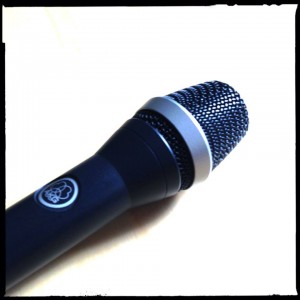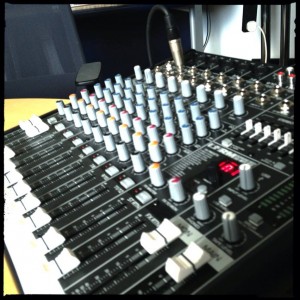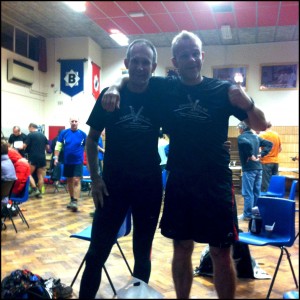Two years after my first attempted at the awesome Montane Lakeland 100 – Ultra Tour of the Lake district, I finally made it around the full 105 miles to collect my finishers medal.

While I could give you a blow by blow account of every nail biting moment of it, I’m pretty sure that every twist and turn of the route has already been covered in some detail on the many excellent accounts already posted. So what I’m going to do instead is say a few thank you’s and to share some of the lesson’s I’ve learned from the experience of my first 2 100 milers.
Suffice to say that I had a great time in the Lakes, the race organisers Marc and Terry did a fantastic job once again (despite a supplier letting them down by all accounts), the sponsors and marshals were brilliant (despite the rain). One of the things I love most about the Lakeland is that every section and every checkpoint is different, the volunteers really make a huge effort, dressing up, making sure that they had everything that you might need for the next section and generally going the extra mile. (A special mention goes to Jo Allan – for driving around and collecting the fruit to make the smoothies at Kentmere happen after the delivery issue, still my favourite check point Jo! – I hope the car doesn’t still smell of fruit though! Also a quick mention to Sunderland strollers who manned the Wasdale checkpoint this year – outstanding effort!).
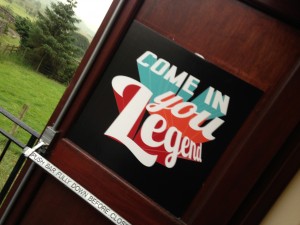
As you might expect I met lots of new and interesting people, I put a few names to faces from facebook and caught up with many old friends. I also had a toenail painted green by a guy I’d never met before and recorded some people for the British Trail Running podcast. Having read various blog posts on the run, I think as with most events of this kind, its the people that you run and chat with on the day that make the event all the more memorable for us as individuals, and in my case I would like to thank, Chris Tetlow, Chris Enwright, Darren Gillman, Shaun Dunlop, Emma Waterfall, Tara and Lawrence Johnson, Steven Major, Tony Holland, Wayne penrose Nick Ham, the triathalon guy (sorry can’t remember your name), Jon Steele, Annie Gracia, Kevin O’neill and all of the Sunderland Strollers. Also to Paul Stoneley who took a long detour on a drive home to run the last 20 miles of the Cotswold 100 with me, getting my first hundred in the bag and taking the pressure off for the Lakeland! But most of all massive thanks my wife and family who’s texts and messages kept me going and who puts up with the hours of training and constant droning on about running.

So down to business, what did I learn from my first Lakeland 100 and just under 34 hours on the trail? Well I guess I learnt a lot more expected, some of which I guess I knew all along, others were things I thought I knew but the actually had no idea about at all when it came to it. But the big lessons were that while training is important, getting plenty of sleep before the race, running at my own pace, effective temperature control, proper foot care, carrying the right kit, getting nutrition right and maintaining a sense of humour no matter what happens makes all the difference in the world.
Training
My last post went into the preparation for the race in detail, so I’m not going to go into it in again, but essentially I discovered that it was possible to run two hundred milers within a month of each other and that I did not have to put in lots and lots of long hilly runs in training to achieve this level of fitness, as long as I stuck to my planned weekly mileage I could do most of my training just run to and from work.
Pacing
In 2011, having signed up to the Lakeland 100 with 3 friends I’d ran with in India the year before, come the day of the race only two of us remained but while I knew Iryna hadn’t done as much training as I had, nor was she perhaps not quite as fast as I was, we had agreed to stick together and I was happy to be running with her again, but it soon became apparent that she was struggling to keep up as we slipped further and further behind the field. Eventually Iryna called it a day at Wasdale as I continued alone trying (to no avail) to make up for lost time before finally timing out at Buttermere. This time around I’d stick to my own pace and if that pace matched anyone else’s then we’d run together for a while, but I wasn’t going to deliberately try to run keep up with people running faster than me or slower down where I could run faster, even if that meant running on my own some of the time.
[Lesson 1: While its fun to run with friends, don't let their bad day spoil yours - you will inevitably both find yourself running with someone running the same pace sooner or later!]
As it happened there were about 5 or 6 of us running at roughly the same pace and we all went though little rough patches dropping back for a while then recovering and catching up again at the next check point. This seemed to work really well – the dynamic of the group was constantly changing as people dropped back then caught up and I found yourself talking to different people at different times, so the conversation never dried up and our little group slowly made its way up from around 100th to 66th place.

At one point I had dropped quite a long way back from from the rest of the group and met up with Kevin O’neill and a couple of the Sunderland Strollers who kindly kept me company for a couple of miles of tabbing from Ambleside to Chapel Style to catch up with the rest of my little group.
The other thing I did differently this year in terms of pacing was not to really thing about it too much. I didn’t worry about how far i’d come or how far I had to go, I simple took it one checkpoint at a time , deliberately not looking at my watch or think about how far it was until the next checkpoint, just running at a pace that worked for me.
[Lesson 2: it's your race run it at your own pace, don't worry if you drop back for a while, chances are after a little recovery you will soon catch up!]
Temperature control
While not as sunny as it was 2 years ago (in my opinion that is – I don’t have any data to back that up), it was a very warm weekend yet at the same time it possibly rained harder than this year than it has in previous years (again that s my opinion it’s probably rained for longer than it did this year but not as hard as far as I am aware), making maintaining body temperature a challenge whichever way you look at it.
The warm weather worked very much in my favour during the first night’s running, the worst of the heat was out of the sun shortly after we set off and I was comfortable in a t-shirt all night long, so did not need to take time out to layer up. That being said it was that warm that I was sweating on all the up hills even during the middle of the night and had to taken on plenty of water through out the night.
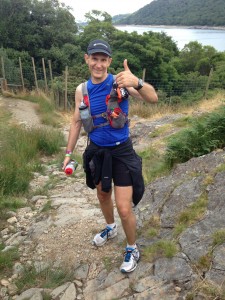
As the sun came up on Saturday it looked like being a really sunny day and I worried a little that i’d left my sunblock in the half way drop bag, as it happens we reached Dalemane in reasonable good time and I was able to get some sun block before being burnt, I also opted to go with a sleeveless compression t-shirt having learnt that your body uses a huge amount of its energy keeping you cool reducing your ability to run, so any help you can give it to keep cool pays off, I also kept sleeves out and a longer sleeved soft shell jacket tied around my waist in case the sun went back in.
[Lessons 3 and 4: Staying cool is nearly as important as staying warm! and never forget the sunblock you never know when you'll need it!]
Fortunately I didn’t need to put the jacket on for much of the day, well not until that brief shower and a bit of thunder later on. I stuck with the soft shell jacket later on as it was handy and saved going into my pack in the dark, even as the rain grew heavier…big mistake, by the time the rain had become torrential I was soaked to the skin, going up towards Tiberthwaite with 3.5 miles to go I was starting to shiver, but knew that there was no point in stopping to get better water proofs or another base layer as soon as I opened my pack everything would be wet through no there was only one option, push on to the cover of a checkpoint and change there. Getting in to Tiberthwaite, it was obvious everyone else had had the same idea, marshals helping people into water proof leggings everywhere you looked.

I stripped off the wet layers replacing them with warm dry HH base layers and my beloved Montane Minimus Waterproof jacket (opting to stay in cycling shorts for now), with the warm,dry cloths on and a mug of soup inside of me I was warmed up in minutes and managed to stayed dry for the rest of the night. It’s at times like these when you are glad that the minimum required kit list is there. Prior to the race there had been a lot of discussion on just how waterproof a waterproof had to be and why we needed extra base layers on such a sunny weekend. No one was questioning this now, and I was extremely glad I’d invested the extra few pounds on the Minimus. Others were less fortunate either having water get through their water proofs, not having dry clothes or having left it too late and being unable to get warm again.
[Lesson 5: Carry the appropriate the gear for the weather and don't wait until its lashing it down to get it out!]
Luckily I’d put everything in dry sacks inside my race pack, because as great as the UltraAspire Surge is, its not waterproof, I was also lucky enough to had a spare dry sack to stick the wet clothes into and clip on to the side of the pack so as not to wet everything else.
[Lesson 6: If your pack/vest is not water proof pack everything in dry bags and carry a spare!]
Nutrition
I thought that I had Nutrition cracked after the Cotwold 100, where i’d learned that less is sometimes more, and that provided I filled my water bottles at each check point and finished them before the next, all I really needed was a gel or a flapjack every hour or so with the occasional pepperoni or banana thrown in and a handful of haribo at checkpoints and a rice pudding or two at the half way stage.
[Lesson 7: Graze! Little and often! and try and get as much variety as possible, you'll soon get sick of stuff if you eat it checkpoint after checkpoint!]
This was all thrown out the window to some extent during the Lakeland for a start in the heat, I really didn’t feel much like eating. It was much harder to know what I needed in terms of salt , electrolytes energy drinks versus plain water (the lakeland tap water seems to have a lot of fluoride or something) and I got really fed up with it really quickly.

The checkpoints were really well stocked with gels and biscuits and things like that, but seemed to lacked the variety as previous years and none of them had any kind of fruit or anything that wasn’t heavily processed, luckily I had a few treats like cola lollies and cherry infused raisin that were a bit more palatable when I couldn’t face anything else.
[Lesson 8: Don't rely on the checkpoints having everything you'll need pack a few treats in your pocket and your drop bag that you know you will eat even if you can't stomach another gel!]
Foot care and appropriate Footwear
A few years ago I felt very strongly that I needed to have the right footwear for the right race, I had Asics’s for roads, Inov8 Mudclaws for fell, Rocklites for mixed terrain, Five Fingers for barefoot and Xtalons for everything else.
But after getting I blisters from a new pair of Mudclaws just before last years Lakeland 50 I had the dilemma to deciding between risking more blister from my fell shoes or the lack of grip with road shoes that I knew wouldn’t rub. I went with the road shoes, and it went really well! I questioned the need for so many different shoes and went on to run the Hardmoors 60, 55 and Alendale all in Asics, two of which were in deep snow. I was happy in the believe that my road shoes were not only comfortable but could handle anything I threw at them.
What I didn’t know was that Asics would discontinue the 2180′s in favour of the newly designed 1000′s just before the Cotswold 100 and that I wouldn’t be able to simply go out and buy another pair. Consequently I ran the entire Cotswold 100 and half the Lakeland 100 in my old Asics which had already done 500 miles. They finally died just after Dockray, luckily I had the new 1000′s in my drop bag and was able to change mid race.

The prospect of getting wet feet and the problems resulting from running in wet trainers for hours on end was about as far from my mind as you could possibly get when I lined up on the start line. But at some point and I don’t remember when we must have been running in some kind of bog because my feet were about as wet as they could get and they weren’t drying out. By the time I could change into dry shoes and socks they were in pretty bad shape, essentially i’d been running on wrinkled up prune feet for quite some time and each of the little ridges had become a little blister.

[Lesson 9: Looking after your feet during a race by loosing a few seconds here and there to tighten your laces or change wet socks mid race is a lot less painful than post race treatment!]
Going into the second half I tried to keep the new shoes dry for as long as possible, and did a pretty good job right up until the heavy rain in the last few miles, but by this time i’d kind of got use to the pain and it didn’t really make much difference. I did have another lesson to learn though, while running on trails in road shoes is just fine 90% of the time, the 10% of the time when your descending down rocky paths in pour rain at night you really need something with a bit more grip, because bouncing off big rocks on your bump after 100 miles is just just no fun at all.
[Lesson 10: You may not need as many pairs of running shoes as Lawrence Johnson, and 90% of the time you will be fine in road shoes, but if there is any chance at all of bad whether your better off with shoes with at least a bit of grip if your going to run on trails!]
Final words go to my friends at Montane, who continue to sponsor this fantastic event year after year and as whom’s guest I ran this years event! Having sworn not to do the 50 again after last year, I really don’t thing I would have have entered the 100 had you not offered me a place! Many,many thanks for pushing me into it, and helping me run further, faster!



